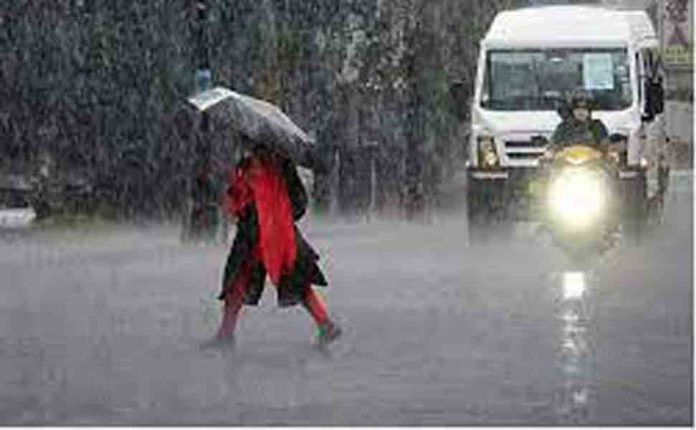The relentless heatwave in North India has been a cause of great distress, with temperatures consistently soaring above 40 degrees Celsius. However, much-needed relief is on the horizon. According to the Meteorological Department, the monsoon rains are expected to begin in most parts of North India by June 25. This year, the monsoon is right on schedule, promising a respite from the oppressive heat.
Current Monsoon Progress and Forecast
At present, the monsoon rains have already reached the southern part of Maharashtra, bringing relief to South and Northeast India. Over the next week, these rains will advance further, encompassing Madhya Pradesh, Chhattisgarh, Jharkhand, and Gujarat. The timely arrival of the monsoon is crucial for the agricultural activities in these regions, ensuring the health of vital crops.
Heatwave Conditions to Persist in Some Regions
Despite the imminent arrival of the monsoon, certain regions in East India, Uttar Pradesh, and North Madhya Pradesh are likely to experience heatwave conditions for the next five days. This forecast has been issued by the Meteorological Department, highlighting the continued need for caution and preparedness in these areas. Residents are advised to stay hydrated and avoid prolonged exposure to the sun.
Rainfall and Thunderstorms Expected in North-West India
The Meteorological Department has also forecasted rain with thunder in North-West India on Friday. This prediction includes regions like Punjab, Haryana, and parts of Rajasthan, which are expected to see a significant change in weather patterns. The anticipated rain and thunderstorms will not only cool the temperatures but also improve air quality by reducing dust and pollutants.
Heavy Rainfall in Coastal Maharashtra and Karnataka
On June 8, the coastal areas of Maharashtra and Karnataka are set to experience heavy to very heavy rainfall. This forecast is particularly important for the coastal regions, which often face challenges related to flooding and waterlogging during intense monsoon spells. Authorities are likely to take preventive measures to minimize the impact on infrastructure and daily life.
Weather Changes in NCR and Delhi
In the National Capital Region (NCR), including Delhi, there is a possibility of dust storms or thundershowers accompanied by light rain. These weather conditions are expected to bring a temporary respite from the heat, with strong winds blowing at speeds of 30 to 40 km per hour. This change in weather is attributed to a western disturbance affecting the region.
Western Disturbance Impact on Weather
Western disturbances are a key factor in altering weather patterns in North India, especially during the pre-monsoon and monsoon seasons. These disturbances often lead to thunderstorms, dust storms, and short spells of rain, providing much-needed relief from the heat and improving air quality. The current western disturbance is likely to enhance these effects in NCR and surrounding areas.
Anticipated Benefits of Timely Monsoon
The timely onset of the monsoon is expected to bring multiple benefits across various sectors in North India.
Agriculture and Crop Health
Agriculture is heavily dependent on monsoon rains, particularly in regions that lack extensive irrigation systems. Timely and adequate rainfall is crucial for sowing and nurturing crops such as rice, maize, and pulses. A good monsoon season can significantly boost crop yields, ensuring food security and stable prices.
Water Resources and Reservoir Levels
Monsoon rains play a critical role in replenishing water bodies, including rivers, lakes, and reservoirs. These water resources are essential for drinking water supply, irrigation, and hydropower generation. An on-schedule monsoon will help maintain optimal reservoir levels, mitigating water scarcity issues in the upcoming dry months.
Temperature Regulation and Air Quality
The arrival of monsoon rains will bring down temperatures, providing relief from the sweltering heat. This cooling effect is vital for public health, reducing the risk of heat-related illnesses. Additionally, the rains will help settle dust and pollutants, significantly improving air quality in urban and rural areas alike.
Precautionary Measures and Public Advisory
While the monsoon brings numerous benefits, it also necessitates certain precautions to ensure public safety and well-being.
Flood Preparedness and Infrastructure
Regions prone to heavy rainfall and flooding should implement preventive measures to mitigate the impact. This includes ensuring proper drainage systems, reinforcing embankments, and setting up emergency response teams. Public advisories should emphasize safety measures, such as avoiding waterlogged areas and staying updated with weather alerts.
Health and Hygiene Considerations
Monsoon season often sees an increase in waterborne diseases and infections. Public health advisories should focus on promoting hygiene practices, such as using clean drinking water, avoiding stagnant water, and maintaining cleanliness in and around homes. Immunization drives and health camps can also help in preventing disease outbreaks.
Long-Term Climate Patterns and Adaptation
Understanding and adapting to long-term climate patterns is crucial for building resilience against extreme weather events. The timely arrival of the monsoon this year underscores the importance of accurate weather forecasting and climate monitoring.
Climate Change and Monsoon Variability
Climate change is leading to increased variability in monsoon patterns, affecting the predictability and intensity of rainfall. This necessitates the development of robust climate models and early warning systems to better anticipate and manage the impacts of monsoon variability.
Sustainable Practices and Environmental Conservation
Promoting sustainable agricultural practices, water conservation, and reforestation can enhance the resilience of ecosystems and communities to climate change. Efforts to conserve and restore natural habitats also play a vital role in maintaining ecological balance and supporting biodiversity.
A Season of Hope and Preparation
The anticipated arrival of the monsoon by June 25 marks a season of hope and renewal for North India. As the region braces for the much-awaited rains, it is essential to stay informed, prepared, and resilient. The monsoon not only brings relief from the heat but also revitalizes the environment, agriculture, and water resources. By adopting proactive measures and sustainable practices, we can maximize the benefits of this vital season and ensure a prosperous and healthy future for all.







